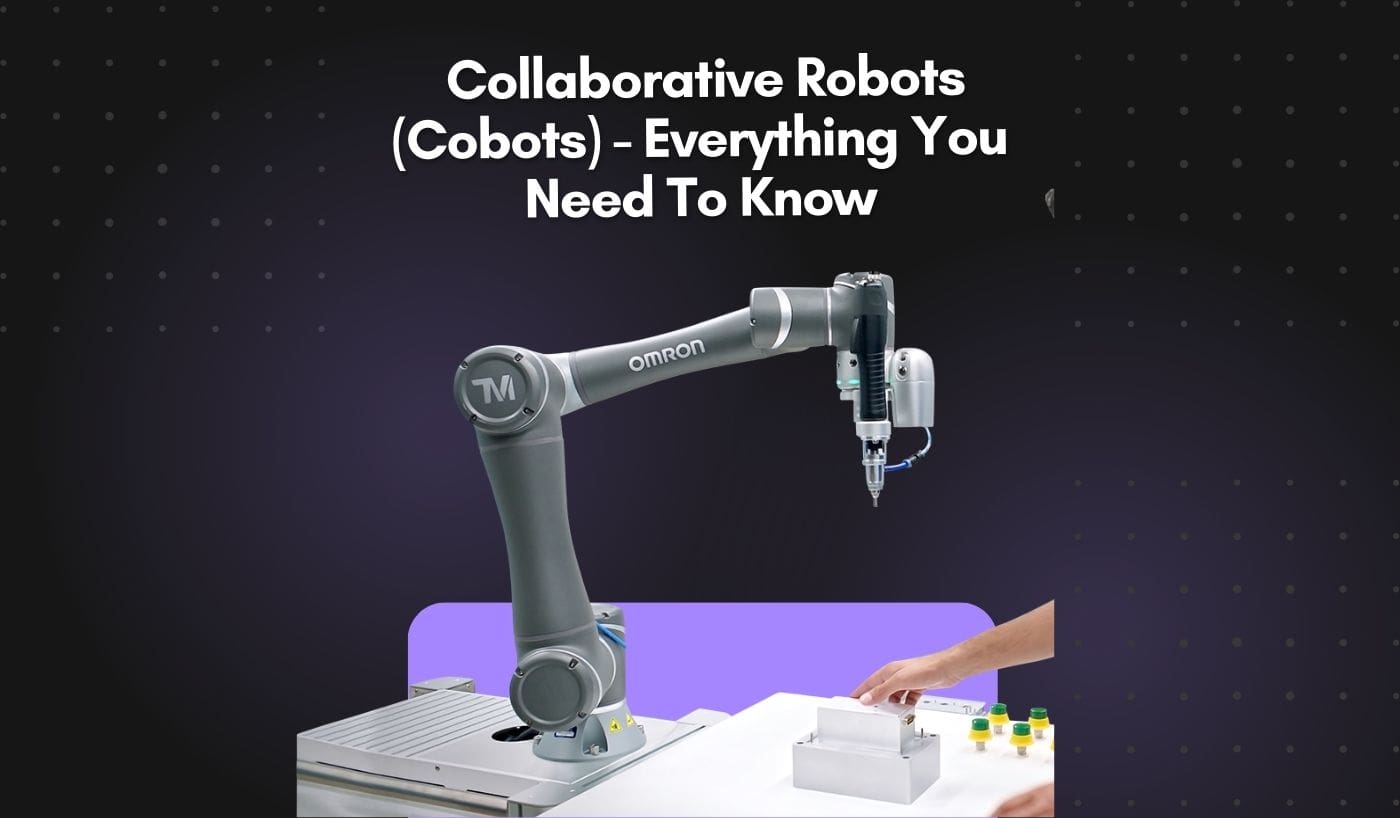Large enterprises have used outdated industrial robots for automation throughout the years. Although efficient, these robots were costly, complicated, and designed for high-volume production. Smaller enterprises with low-volume, high-mix manufacturing processes found it challenging to reap the benefits of automation. This automation led to the birth of a revolutionary technology named Collaborative Automation.
Collaborative Automation is a flexible, affordable, and user-friendly solution that may assist businesses of all sizes in increasing productivity, improving product quality, and swiftly adapting to changing client requirements. It acts as a corporate superhero, resolving problems with the supply chain, hiring shortages, and sustainability.
The emergence of Cobots (Collaborative Robots) is one of the most exciting advances in collaborative automation. In contrast to their conventional counterparts, Cobots are built to collaborate with human employees, fostering a whole new level of collaboration on the factory floor. Cobots can interact and cooperate with people securely in shared workspaces and many other situations because of their cutting-edge sensors, simple programming interfaces, and safety measures.
Explore farther and delve deeply into the Cobot universe.
What are Cobots?
A collaborative robot, often known as a Cobot, is a robot that enables direct human-robot to contact without the need for typical safety barriers. Direct human connection with Cobots has the following advantages:
- Safe completion of challenging tasks
- The high caliber of production
- Logical and user-friendly Cobot training and programming
What is the Brief History of Cobots?
Did you know that the first Cobot was created in 1996? J. Edward Colgate and Michael Peshkin, two outstanding academics from Northwestern University, were the catalysts for everything. They ensured that these Cobots had no internal source of power since they intended to build robots that could safely operate alongside people. Genius, right?
Cobotics was started in 1997 by Colgate and Peshkin. They created Cobot models to utilize in the final assembly of automobiles. They were purchased by Stanley Assembly Technologies in 2003.
The Cobot revolution, however, continued. 2004 saw the launching of LBR 3, KUKA’s very own Cobot. This little robot led to extensive work with the German Aerospace Centre organization. They were committed to building an all-purpose Cobot that could be operated by a computer.
The UR5 Cobot from Universal Robots then joined the fray in 2008. This robot was unique because it could operate beside people without any fence or safety enclosures. The revolutionized field of robotics ushered in a new era of adaptability, use, and cost-effectiveness.
Rethink Robotics responded in 2012 with Baxter, an industrial Cobot. This robot is ideal for companies that demand the highest level of accuracy because it was built for precise operations. And then in 2015, just three years later, they unveiled Sawyer, a more compact and quicker Cobot. These robots served the Cobotics industry’s ongoing innovation and advancement.
Next, from 2009 to 2013, the Carnegie Mellon University CORAL research group created, constructed, and programmed four Cobots. Speaking of pushing the limits of creativity, the development of Cobotics was further accelerated in 2015 with the launching of FANUC’s first Cobot, named CR35iA. With every new edition, the improvement has continued, getting better in terms of features and capabilities.
We now find ourselves in the present. Exoskeletons are a hot topic right now! People with mobility impairments, as well as the military and business, employ these wearable robots. They offer fantastic help and support, but they’ve always been costly and difficult to get. These robotic limbs will be inexpensive enough for just about everyone to afford, thanks to tremendous technological breakthroughs.
What are the Cobot Applications for the Next 20 Years?
1. Cobots in Automotive Manufacturing
Cobots are being utilized more often in the automobile industry to complete activities like surface cleaning and car assembly. Many auto assembly lines need to be modified or rebuilt in response to the development of electric vehicles. Large automakers have a dilemma because if one industrial robot breaks down, the entire production line must be shut down for inspection, resulting in expensive downtime. Cobots, on the other hand, provide a solution since they let human operators collaborate directly with robots without affecting other robots.
2. Cobots in Quality Control and Assembly
Cobots from Universal Robots were developed to work alongside human employees, relieving them of tiresome and demanding assembly tasks. Welding tiny components together, drilling screws, and other assembly duties fall under this category. Cobots can also help with quality assurance during the manufacturing process. Cobots, for example, may deploy a camera in the same area for as many measurements and locations on as many work components as needed – all without the need for optical recalibration.
3. Cobots in the Electronics Industry
In the electronics sector, Cobots examines the integrity of electronic components, including PCB inspection, PC processor inspection, and phone chip inspection. While some predict a decline in the market for PCs and smartphones in the coming years, the need for PCBs is rising as more electronic devices become commonplace. Compared to manual inspection, using Cobots for electronics inspection has many benefits, including reduced possibility of human error and increased efficiency and accuracy.
4. Cobots Performance in Repetitive Task
Carrying out routine chores boosts overall productivity. Cobots can even do some of the basic jobs. Robotic assistance may significantly speed up procedures since Cobots can be trained to complete tasks quickly and accurately. According to Forbes, pick-to-cart rates have increased from 90-200/hr., thanks to Bots from 6 River Systems. Due to the implemented pattern, robots can also help sort goods or bundles of various sizes and sorts.
What can we expect from Cobots in 2024?
1. The Rise Of Plug & Produce Solutions
Rapidly integrable automation systems, Plug & Produce solutions can be quickly set up and operated with minor adjustments. These options, which include palletizers and box folders, facilitate and expedite the implementation of automation.
2. Manufacturers Put More Emphasis On Flexible Production
Cobots are well suited for the flexible production methods manufacturers are moving towards. Cobots are safer and more suited for flexible and adaptable situations since they are light, adaptable, and made to operate alongside people. By 2026, it is expected that the Cobot marketwill increase to $2.2 billion, and modular robotic work cells will be increasingly commonplace.
3. Improvements to the Cobots’ Payload and Reach
The reach and payload capacity of Cobots are also improving. There are still applications where a bigger payload or better reach is necessary, even though they now control a substantial piece of the automation industry. To fulfill these expectations, Cobot manufacturers have been trying to create robots. Models like the UR20 and TM20/TM25 provide more payload and extended reach. The breadth of jobs that may be automated will increase because of these developments.
4. Increased Focus on Customer Collaboration
The importance of customer feedback in product development is rising. Customers are increasingly aware of their wants as the automation sector develops, and they may offer vital feedback to robotics businesses. Customers may now directly influence the things they buy, thanks to this partnership.
Cobots – Outlook!
In 2023, Cobots will pave the way for innovative advancements and opportunities. Numerous businesses are involved in pick and place (P&P) solutions and looking forward to sophisticated Cobots like the UR20 and TM20.
Particularly, Cobots are set to become an essential tool in the workplace as they develop and get better, thanks to advantages including higher productivity, flexibility, and safety. Moreover, Cobots will swiftly take a sizable portion of all robot sales as they become an in-demand technology, delivering cutting-edge capabilities to a larger range of sectors and applications while fostering long-term market growth.




